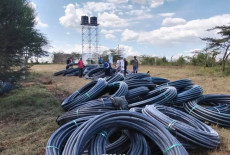- Back then, it was easy to spot the difference. No electricity. No running water. It wasn’t just about geography, it was about access, opportunity, and empowerment.
When you think of rural homes, what often comes to mind is a way of life that feels worlds apart from the urban structure. You find people living simple lives, making do with the resources available at the time.
It’s a rhythm shaped by nature, necessity, and resilience. There was a time when rural homes stood as quiet symbols of endurance. Built from mud, sticks, and hope, they sheltered generations through droughts, harvests, and hardship. But they also carried the weight of limited access to clean water, safe cooking, and basic sanitation.
Back then, it was easy to spot the difference. No electricity. No running water. It wasn’t just about geography, it was about access, opportunity, and empowerment.
But today, that line is fading fast. On October 8, 2025, the Prime Minister of the Federal Democratic Republic of Ethiopia, Abiy Ahmed Ali, officially handed over the model rural villages built through Ethiopia’s Rainy Season Voluntary Scheme in the Halaba and Kembatta zones to their new residents.
According to him, these villages mark a promising beginning in transforming the lives of Ethiopia’s farmers. The houses are powered by solar energy, use biogas from animal waste for cooking, and include independent living spaces, toilets, and service quarters. Separate animal shelters have also been built, improving hygiene and living conditions.
Read More
“These Rural Corridor Villages will continue to expand as part of our vision to raise rural living standards. Over the past seven years, our Rainy Season Initiative has provided housing for those in need in cities. Now, through the Rural Corridors Initiative, we are extending this progress to rural areas,” he said.
Similarly, in Kenya, rural electrification has become one of the country’s most transformative development efforts, bringing light, opportunity, and dignity to communities that were once left in the dark.
Since July 2025, Kenya has launched at least 29 rural electrification projects, averaging one village per day. Counties like Kwale, Uasin Gishu, Kisii, Embu, and Kajiado have seen rapid rollouts of grid extensions and off-grid solutions.
Before the 2000s, electricity access was largely concentrated in urban centers. Rural areas relied on kerosene lamps, firewood, and diesel generators. But things began to shift. In 2004, the government launched the Rural Electrification Programme (REP) to expand grid access to underserved areas.
In 2013, the creation of the Rural Electrification and Renewable Energy Corporation (REREC) marked a move toward structured, long-term planning. Under Vision 2030, electrification became a key pillar of Kenya’s national development blueprint, aiming for universal access to affordable and clean energy.
As of 2025, 87% of Kenyans live in areas served by the national grid, though 36% of households remain unconnected, especially in remote and economically disadvantaged regions. But the momentum is undeniable.
This mass rural electrification effort is redefining what it means to be rural. With solar panels, biogas systems, and smart mini-grids, rural homes are becoming hubs of innovation, blurring the lines between village and city.
To stay connected with stories like this, follow us on X and WhatsApp.

-1759927128.jpg)










